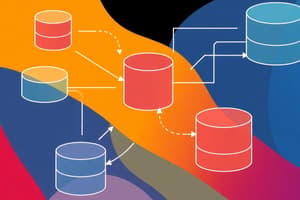Podcast
Questions and Answers
What is the primary goal of the data modeling process?
What is the primary goal of the data modeling process?
- To ensure data is stored randomly for flexibility
- To eliminate the need for requirements analysis
- To create an initial database layout only
- To develop a data model that optimizes database performance (correct)
Which of the following steps is NOT part of the data modeling process?
Which of the following steps is NOT part of the data modeling process?
- Maintaining a Data Model
- Building a Data Model
- Architectural Design Review (correct)
- Planning and Requirements Analysis
What does the Requirements Gathering step primarily focus on?
What does the Requirements Gathering step primarily focus on?
- Outlining code implementation techniques
- Identifying technical specifications for database servers
- Understanding the data needs from stakeholders (correct)
- Creating visual designs for the user interface
How are entities typically categorized in the data modeling process?
How are entities typically categorized in the data modeling process?
What types of relationships can exist between entities in the data modeling process?
What types of relationships can exist between entities in the data modeling process?
During which step of the data modeling process is the model validated and tested?
During which step of the data modeling process is the model validated and tested?
What is the significance of maintaining a data model over time?
What is the significance of maintaining a data model over time?
What does a conceptual model primarily represent in data modeling?
What does a conceptual model primarily represent in data modeling?
What is a key feature of a logical model compared to a conceptual model?
What is a key feature of a logical model compared to a conceptual model?
What aspects are included in the physical model of data modeling?
What aspects are included in the physical model of data modeling?
How is the validation of a data model conducted?
How is the validation of a data model conducted?
What is the main goal of normalization in data modeling?
What is the main goal of normalization in data modeling?
What does scalability in data modeling require?
What does scalability in data modeling require?
What is a critical consideration for data security in data modeling?
What is a critical consideration for data security in data modeling?
How is data integrity maintained in data models?
How is data integrity maintained in data models?
What essential step follows the validation of a data model?
What essential step follows the validation of a data model?
In data modeling, what is denormalization mainly focused on?
In data modeling, what is denormalization mainly focused on?
What role does indexing play in the physical model of database design?
What role does indexing play in the physical model of database design?
Why must the data model be aligned with business goals?
Why must the data model be aligned with business goals?
Flashcards
What is the primary goal of data modeling?
What is the primary goal of data modeling?
The primary goal of data modeling is to create a data model that aligns with application requirements, ensures data integrity, and optimizes database performance.
What are the main steps in the data modeling process?
What are the main steps in the data modeling process?
The key steps in data modeling include: Planning and Requirements Analysis, Building a Data Model, Validation and Testing, and Maintaining a Data Model.
What activities are included in the Requirements Gathering step?
What activities are included in the Requirements Gathering step?
Requirements Gathering involves gathering information about the data needed for the application, identifying key entities, data flows, and relationships based on business requirements.
How are entities and relationships defined in data modeling?
How are entities and relationships defined in data modeling?
Signup and view all the flashcards
Conceptual Model
Conceptual Model
Signup and view all the flashcards
Logical Model
Logical Model
Signup and view all the flashcards
Physical Model
Physical Model
Signup and view all the flashcards
Validating the Data Model
Validating the Data Model
Signup and view all the flashcards
Implementing and Refining the Data Model
Implementing and Refining the Data Model
Signup and view all the flashcards
Normalization vs Denormalization
Normalization vs Denormalization
Signup and view all the flashcards
Scalability in Data Modeling
Scalability in Data Modeling
Signup and view all the flashcards
Data Security in Data Modeling
Data Security in Data Modeling
Signup and view all the flashcards
Data Integrity
Data Integrity
Signup and view all the flashcards
Defining Entities
Defining Entities
Signup and view all the flashcards
Defining Relationships
Defining Relationships
Signup and view all the flashcards
One-To-One Relationships
One-To-One Relationships
Signup and view all the flashcards
One-To-Many Relationships
One-To-Many Relationships
Signup and view all the flashcards
Many-To-Many Relationships
Many-To-Many Relationships
Signup and view all the flashcards
Study Notes
Data Modeling Process Overview
- Primary Goal: Create a data model that fulfills application needs, ensures data integrity, and optimizes database performance.
- Key Steps: Planning & Requirements Analysis, Building a Data Model, Validation & Testing, Maintaining a Data Model.
Requirements Gathering
- Stakeholder Involvement: Gathering information from stakeholders about data needs, identifying entities, data flows, and relationships based on business requirements.
Entity and Relationship Definitions
- Entities: Defining main objects (e.g., Customers, Orders, Products).
- Relationships: Specifying how entities interact (One-to-One, One-to-Many, Many-to-Many).
Conceptual Model
- High-Level Representation: Outlines entities and relationships without detailed attributes.
- Stakeholder Review: Ensures alignment with business goals.
Logical Model
- Detailed Attributes: Specifies data types, keys (primary and foreign), and normalizes data.
- Normalization: Reduces redundancy, improves consistency.
Physical Model
- DBMS Mapping: Translates logical model to the chosen DBMS.
- Technical Details: Specifies data types, indexing, storage, query optimization.
Validation and Testing
- Performance and Scalability: Reviews the physical model to ensure it meets requirements for handling real-world data volume and queries.
- Testing: Confirms that the model is efficient with actual data scenarios.
Implementation and Refinement
- Database Creation: Creates tables, indexes, and constraints.
- Performance Monitoring: Continuously observes database performance and adjusts as needed.
Normalization and Denormalization Balance
- Normalization: Reduces redundancy.
- Denormalization: Optimizes query performance.
- Balance: Maintaining data consistency while ensuring efficient data retrieval.
Scalability
- Future Growth: Designing the model to support future increases in data volume and complexity.
Data Security
- Access Control: Including measures to protect sensitive information.
- Authorization: Ensuring that only authorized users can access or modify data.
Data Integrity
- Accuracy and Consistency: Ensuring the accuracy and consistency of data.
- Maintenance: Maintaining integrity using constraints and relationships.
Studying That Suits You
Use AI to generate personalized quizzes and flashcards to suit your learning preferences.




